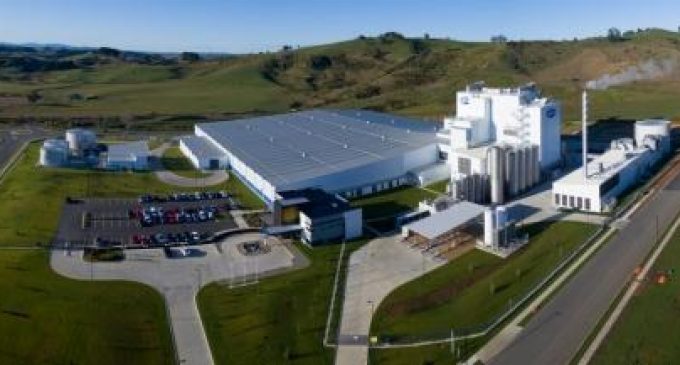GEA Infant Formula Plant For Yashili Starts Production in New Zealand

GEA has built a complete processing plant for infant formula production for Yashili, one of the Big Three producers for the Chinese market. The new plant in Pokeno, 50 km south of Auckland, was completed on time and on budget and has already started production.
With a production capacity of 50,000 tons a year, this plant is one of the largest infant formula plants in the world. It is a showcase plant for Yashili that places special focus on innovation and on the hygienic design of the process plant and buildings.
Yashili started construction on the new plant in September of 2013. GEA was chosen as the main process contractor because of its reputation in New Zealand for building dairy processing plants to the highest international standards.
The scope supplied from GEA includes all the key elements: from milk and ingredients reception, to powder production, and to final packing into 25-kg bags. All of the main processing technology from GEA assures absolute compatibility and design optimization.
Process Overview
- Milk is received at the Pokeno site and pre-treated. Ingredients are accurately added using high shear mixing under vacuum. Vegetable oils, dry dairy powders, carbohydrates, vitamins, and minerals can then be added directly to fresh milk. The resulting formulations are cooled in batches.
- The batches are then further concentrated by gentle removal of water under vacuum, using GEA tubular falling film evaporators.
- The milk concentrate from the evaporators is spray-dried in a GEA MSD dryer to produce a dry powder with high functionality.
- GEA Avapac technology is used to pack the powder into 25-kg bags.
Innovation
The plant includes a number of highly innovative technologies designed to enhance product quality and consistency, reduce noise pollution, and minimize the use of water and energy:
- Operations on 24-hour basis. GEA has designed the plant with multiple feed lines and duplicate up-stream systems (such as for evaporation) to allow continuous, 24-hour operations of the dryer. This facility increases output, helps ensure product consistency, and avoids product quality problems associated with start-up and shut-down procedures.
- Built-in flexibility. As well as making infant formula from liquid milk, the Yashili plant can reconstitute milk powders for introduction as ingredients. This allows greater product flexibility and more accurate management of the milk supply.
- Inlet-air dehumidification. The GEA dryer uses dehumidified air and is one of the first spray dryers in New Zealand to benefit from this feature. By dehumidifying the inlet air it is possible to compensate for changes in humidity throughout the day or year, thereby optimizing dryer efficiency and avoiding upsets in the drying process. It also ensures a greater consistency in the properties of the final powder.
- Water recovery. The water treatment system uses reverse osmosis to process water evaporated from the milk, which converts it into high-quality water for reuse within the plant. This reduces water consumption and minimizes disposal costs.
- Exhaust heat recovery. A variety of best-in-class energy recovery techniques are used to recover waste heat and return it to the process. The high dryer-exhaust temperatures associated with the production of infant formula makes heat recovery both practical and cost-effective.
- Reduced noise. Special care has been taken to reduce noise from the plant, owing to its location near residential areas and its 24-hour operation. The building has been designed to contain noise, including the attenuation of noise at ventilation and process exhaust openings. Equipment is also strategically selected and located to minimize overall noise levels from the site.
- Advanced process control. Legislators, retailers, and insurers are placing increasingly stringent demands on the traceability of food products: in particular, food for infants and the new-born. To meet these demands, GEA has included modules from its OTAS software suite for higher-level supervisory control of the Yashili plant. These modules ensure transparency in the production sequence, effective use of resources, and high product quality. The GEA OTAS Track & Trace module especially allows Yashili full and transparent traceability of raw material and ingredient inputs, throughout the process and into the final product.
In addition to process innovations, GEA took on responsibility for all process buildings. This took place in conjunction with its partners Ebert Construction Ltd. for the building work and Silvester Clark Ltd. for building design. This partnership ensured high-level optimization of building space to fully match process needs.
Chris Burt is the engineering manager for GEA in New Zealand. He reported that the Pokeno plant had been a challenging project, but that the company had been able to draw on its long experience of building similar facilities elsewhere in the country and around the world. “We have succeeded in including interesting innovations for Yashili,” he explained. “These have combined to optimize the plant in terms of its productivity, flexibility, and sustainability. It is really a world class facility.”
Terry Norwood is the Operations Manager for Yashili New Zealand operations and has seen the project through from conception until the present. “We have a plant here that represents the best in class in many aspects and that produces an excellent product,” he said. “GEA has been a great partner in this project.”
The Pokeno plant is already producing products and will move into full production in accordance with Yashili’s commercial needs.

































